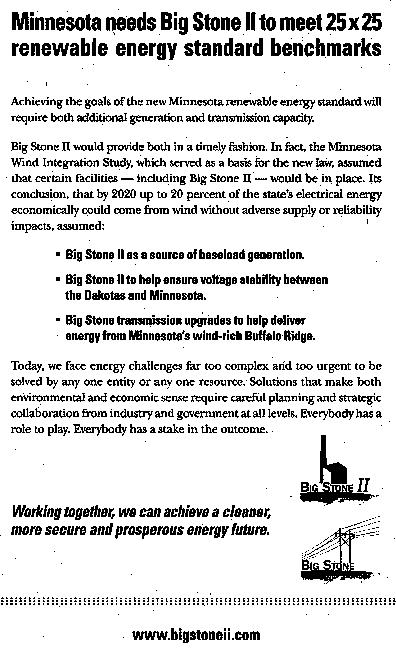Running scared – more BS on BSII
March 18th, 2007

DE’s final RFP public comment hearing
March 17th, 2007
Energy debate continues at series of public hearings
By Rachel Swick
Cape Gazette staffPublic hearings kicked off this week to discuss the future of power in Delaware, while at the same time evaluations of three proposals were released, instantly drawing criticism from two of the power bidders.
The evaluation by state agencies and an independent consultant looked at three proposals submitted to the state Public Service Commission (PSC) and Delmarva Power for a long-term contract for new power.
The proposals include a 200-megawatt natural gas plant from Conectiv, a 600-megawatt coal-gasification plant from NRG Energy and a 600-megawatt off-shore wind farm from Bluewater Wind.
The results ranked Conectiv first, with Bluewater Wind in second and NRG, third.
Jim Lanard, director of strategic planning and communications for Bluewater Wind, said the evaluations were inconsistent, giving such a great advantage to Conectiv for its lower price that the other proposals could not equal Conectiv – even though they may have outscored the natural-gas plant on aspects such as fuel diversity, innovative technology and environmental impact.
“It’s impossible to compare the three companies when Conectiv admits they will change their price in the future,†said Lanard, who questioned whether the price Conectiv quoted for costs associated with natural gas are realistic or just overly optimistic.
Lanard said the evaluation process was inconsistent because evaluators used one scale for price categories and an entirely different method when looking at emissions and environmental impact. He said the same scale should have been used for each factor; had the same scale been used, the overall results would have been different.
“Just with changes to those categories, Bluewater would be considerably ahead,†said Lanard.
Evaluation process flawed
While NRG officials did not agree that Bluewater would be ahead, they did agree that the evaluation did not come out with the best solution to Delaware’s energy problems.
“We absolutely stand behind our proposal, which would allow Delaware to meet its energy needs and environmental objectives affordably with IGCC and carbon capture and sequestration, now and into the future,†said Caroline Angoorly, NRG’s senior vice president for the Northeast Region.
“After reviewing the initial evaluation reports, however, I’m concerned that all of the taxpayer-funded work done to make this a competitive process, with an independent evaluation of the value being offered to the state, has been wasted.â€
NRG concluded that the consultants’ report is fundamentally flawed on many levels. Most notably, the report recommends state agencies do the exact opposite of what the request for proposals was intended to accomplish. The consultants, who ranked each proposal on a point system, gave the most points to a natural gas project – when the process was designed to move Delaware toward greater fuel diversity.
“More natural gas generation means Delaware ratepayers will be vulnerable to more volatile and high gas prices,†said Angoorly. “Moving to IGCC technology would provide increased fuel diversity and would allow us to use U.S. coal, which has much more stable pricing than natural gas and is in abundant supply. And we can use this technology to remove the substances that have traditionally made coal environmentally less desirable.â€
NRG also noted that while the proposed IGCC plant met all seven criteria listed in the request for proposals – including use of innovative baseload technology, existing fuel and transmission infrastructure and existing brownfield or industrial sites – the project ranked a distant third.
“The evaluation process concludes that IGCC – the very technology that leaders around the world are holding up as the next generation of power plants – is wrong for Delaware,†said Angoorly.
NRG submitted these comments to the PSC after reviewing the evaluation reports. NRG maintains that the evaluation was not objective because the consultants relied on models for evaluation that were constructed by Delmarva Power, an affiliate of Conectiv, which was one of the bidders. Angoorly said it would have been better for the consultants to construct their own models, so that the review would have been truly independent.
NRG was awarded no points for its proposal to shut down two of its oldest operating units at Indian River, which would cut down on carbon and other emissions.
“The evaluation process has failed to reflect the real cost to Delaware of a large, intermittent energy resource,†said Angoorly. “If Delmarva chooses offshore wind power, additional power will have to be purchased from another source to meet energy needs when the weather is warm, the wind is not blowing, air conditioners are on and electricity demand and costs are at their highest.â€
Risks merit emphasis
The first of three public hearings was held Tuesday, March 6, in Dover and drew many Sussex County residents and business owners interested in talking about wind.
It also drew many NRG employees, who were bused to the hearing by the company.
Kim Furtado, holistic health expert and Millsboro resident, said she was encouraged by how much average citizens cared and knew about the power question in Delaware. “After examination of the point system used by this RFP process and the consultants’ report, it is clear to me health factors are not included with enough foresight,†said Furtado.
“I urge you to place appropriate perspective on the health risks of each bid as you analyze the consultants’ reports, and honor your historical opportunity to do so.â€
The second hearing, to be held at Delaware Technical & Community College was postponed due to the winter weather on Wednesday, March 7.
It will be held at 7 p.m., Monday, March 12, at Del Tech in Georgetown. The public is welcome to attend.
Toxic Release Inventory 2005 numbers released
Statistics compiled in the Delaware Toxics Release Inventory 2005 indicate a decline in toxic emissions for most big polluters in the state, including the Indian River Power Plant in Millsboro.
“In Delaware, TRI reports for 2005 show that on-site releases reported under TRI were lower by 18 percent when compared to 2004, and they were lower by 29 percent compared to 1998,†said Delaware Department of Natural Resources and Environmental Control (DNREC) Secretary John Hughes upon the release of the data this week.
“One reason for the decrease in reported on-site release amounts is that the Indian River Power Plant had fewer impurities, including chlorine, in the coal it burned in 2005.â€
Indian River Power Plant, owned by NRG Energy, is the biggest polluter in Delaware, but efforts to clean up the plant in recent years are steadily reducing toxic emissions.
In 2004, Indian River reported releasing 241 pounds of mercury into the air and land. That number went down in 2005, when Indian River only released 205 pounds of mercury.
With new regulations from the state and new technology the plant owners plan to install, that number should drop dramatically in the coming years, said NRG officials.
In 2004, Indian River released 130,000 pounds of sulfuric acid into the air. In 2005, that number dropped to 110,000 pounds.
“While there is positive news within the TRI data, there is also some negative news within the program. Recently, the EPA (Environmental Protection Agency) weakened the TRI program by enacting a rule allowing more facilities to report on the TRI short Form A that does not report any amounts,†said Hughes. DNREC sent a letter to the EPA opposing the rule change.
“Fuel quality, as well as amount of energy production, can affect the environment,†said Hughes. “We encourage both industry and the public to do their share to help preserve the environment through greater energy efficiency and material selection.â€
For more information on TRI data, visit www.serc.delaware.gov/services/search/index.shtml
Contact Rachel Swick at: rswick@capegazette.com
Land use challenge – FPL Glades Power Park
March 17th, 2007

Did Lykes, FPL and Glades County come together to alter rules to allow an Everglades power plant?
By Craig Pittman, Times Staff Writer
Published March 15, 2007Tampa-based Lykes Brothers and Florida’s largest utility cut a deal with Glades County officials to illegally rezone 400,000 acres of Lykes land to allow the utility to build a power plant at the edge of the Everglades, an environmental group charged in a lawsuit filed late Tuesday.
The Lykes land, which covers 90 percent of Glades County, had been zoned for agriculture. The rezoning, quietly approved by Glades officials last year, inserted the letter “P” into line number 1,745 of a 2,100-line table in its land-use ordinance, the suit contends.
That small alteration changed the uses permitted in agricultural areas to include power plants.
“They just slipped it by everybody,” said David Guest of Earthjustice, which filed the suit on behalf of five Glades County landowners.

David Guest, Earthjustice
Glades officials weren’t trying to fool anyone, said Assistant County Administrator Larry Hilton. The change was supposed to help Lykes develop a 3,500-home community called Muse Village in another part of the county, he said, not hide Florida Power & Light’s plans for a new coal-fired plant near Lake Okeechobee.
Lykes vice president Mark Morton said his company asked for the change, but agreed with Hilton that this wasn’t about FPL’s new plant.
“We told the county that they needed to add language to allow utilities on agricultural land” to provide power for Muse Village, he said. “After that, the power company thing came up.”
An FPL spokeswoman declined to comment.
To keep pace with rising electricity demands, FPL has been trying for years to build a power plant somewhere in South Florida. Originally, the utility intended to build it in St. Lucie County, a plan that stirred tremendous controversy.
In November 2005, St. Lucie commissioners said no because of pollution concerns and possible violations of the county’s growth plan.
So, in February 2006, FPL officials began talking to Glades County officials about building a 1,960-megawatt plant there. Last September, the utility announced it would build the plant on about 5,000 acres of Lykes-owned farmland 5 miles northwest of Moore Haven.
That puts it within 70 miles of Everglades National Park and 40 miles north of Big Cypress National Preserve. Utility officials say the $5.7-billion plant will employ a technology called advanced supercritical pulverization, burning coal at extremely high temperatures and using extensive filters to make it far cleaner than a regular coal-fired plant.
But last week the Sierra Club, Florida Wildlife Federation and other environmental groups filed papers with the Public Service Commission to oppose the plant, citing concerns about the impact of pollution on the already imperiled Everglades.
Everglades National Park Superintendent Dan Kimball has also expressed concern about the plant’s smokestacks pumping mercury into the air and water. Mercury contamination is already such a big problem at the park that visitors are warned not to eat fish caught there.
The news that Glades commissioners had approved a land-use change that would clear the way for building a coal-fired power plant in their backyard caught local residents off-guard, said Lynn Kilcoyne, who has lived there 20 years.
“I’m amazed at how sneaky they’ve been in all this,” said Kilcoyne, lead plaintiff in the lawsuit.
Records obtained by Earthjustice show that Hilton and County Manager Wendell Taylor met on March 29, 2006, with four FPL executives as well as Morton and another executive from Lykes and Glades County Commission Chairman Butch Jones.
No records show what they discussed. But at that point the zoning code said land zoned for agriculture would not be suitable for commercial and industrial development.
On April 6, 2006, county officials sent out a public notice about a proposed land-use change that made no mention of power plants. After two public hearings at which no one mentioned power plants, the commission in May adopted the change by a unanimous vote.
After the vote, George Whidden of Florida Power & Light sent an e-mail to Glades officials thanking them for the “very substantial progress you have made on our endeavor” and stating “it is indeed a pleasure working with such straightforward folks.”
The suit seeks to stop Glades from being able to use the new zoning for the FPL plant. So far, no hearing dates have been scheduled.
Times staff research Caryn Baird contributed to this story.
Craig Pittman can be reached at craig@sptimes.com or at 727-893-8530.
IGCC – speaking of ED… and NRDC
March 17th, 2007

Steve Jenkins, former IGCC promoter toady extraordinaire, has come clean about coal!
IGCC just can’t get it up, it’s not a happenin’ thang… it’s unreliable… this should be common knowledge, but for some reason, some persist in denial. Why would NRDC and ED say “IGCC is good with capture and sequestration” when it’s NOT good, and “capture and storage” is NOT happening?
Wabash River was utter disaster. Pinon Pines never worked. Carbon capture and sequestration isn’t happening. So at what point do they admit that IGCC is a stupid fork to take, a diversion from the real work of generating and using electricity that we can live with? That works FOR us, rather than poison us. From NRDC’s Coal in a Changing Climate:
There is no such thing as “clean coal.†However, as far as the air pollution and global warming effects of coal are concerned, technologies ready for widespread commercial application can dramatically reduce emissions of carbon dioxide, mercury, sulfur, and nitrogen oxides from coal conversion. Although the other challenges remain, we must employ these technologies now to prevent evenreater damage from coal use. The race for a better energy future is on.
And here’s ED on IGCC:
What’s wrong with this picture? DUH!!! NRDC’s and ED‘s claims are against evidence!!! Obviously they aren’t reading the record of Excelsior Energy’s Mesaba Project.
One of the more public flops was the Pinon Pine project, which for some reason didn’t turn up in my prior searches. Here’s the link:
And of course there’s the:
And based on a career of IGCC promotion and toadism, Steve Jenkins has filed the most amazing testimony in the Florida “Glades Power Park” docket:
So what’s going on in Florida? It’s dreadful — first off, they want to build a 1,900MW pulverized coal plant, the “Glades Power Park.” Pricetag? $5.7 billion! Holy shit!
OK, so if that isn’t enough, dig the testimony of Richard “The Vermin” Furman:
This guy testifies that IGCC in the midwest costs 5.26 cents per kilowatt hour! Well, not quite, he testifies that a DOE report says that’s the cost. HELLO!! DUH!!! Double it and you’re close!
From Dr. Elion Amit’s Rebuttal Testimony in the Minnesota Excelsior case:
Solar/gas combo announced for Arizona
March 16th, 2007
Thanks to Harry for sending this article from Power Engineering that shows yet another utterly sensible option for dispatchable power!!!!! In addition to my fave, the wind/gas combo, now a solar/gas combo has been announced for Arizona:
LS Power to develop solar plant next to gas-fired facility in Arizona
7 March 2007 — LS Power Group has initiated the development of a stand-alone solar power plant near its natural gas-fueled Arlington Valley Energy Facility, a 570 MW combined-cycle plant in Maricopa County, Arizona.
“We have begun serious evaluation of a major thermal solar project on the 3,500-acre parcel we own surrounding the Arlington Valley plant,” said Jason Hochberg, president of LS Power. “This large, flat, very sunny location has tremendous potential to produce clean, renewable energy.”
In addition to the stand-alone project, LS Power is studying the feasibility of building a solar integration project at the same location. Thermal solar units would generate steam for use in the combined-cycle plant, possibly reducing fuel consumption and cutting emissions, including greenhouse gases. The integration project would be among the first ever built for commercial use.
The development project is being undertaken by LSP Polaria, an LS Power subsidiary. When the pending business combination between LS Power and Dynegy closes, the project will be jointly owned by the two companies under the terms of a joint venture arrangement.
Copyright © 2007: PennWell Corporation.
Where can we do CSP and gas?



